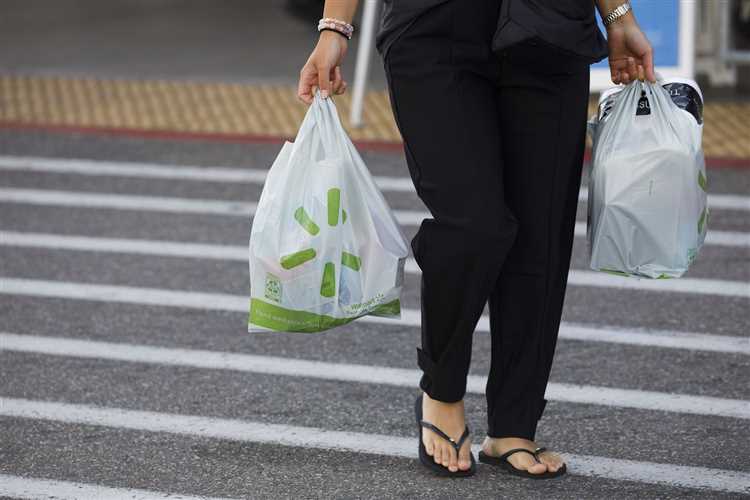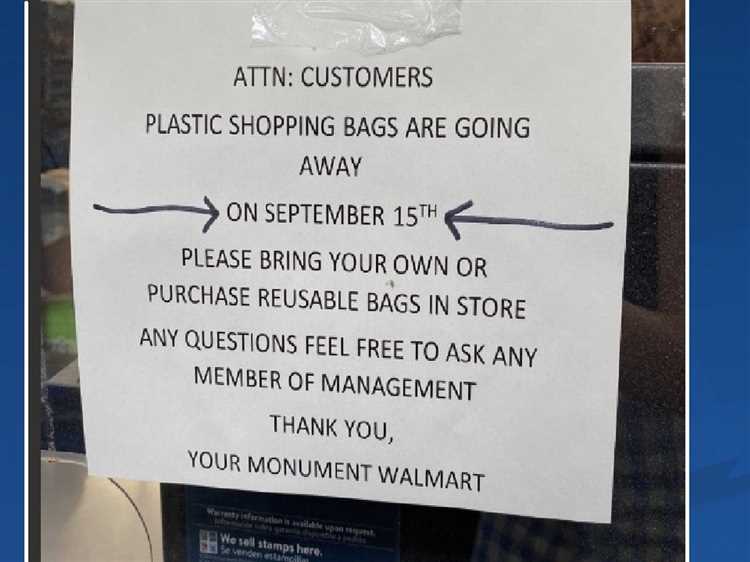
In recent years, there has been a growing concern about the impact of single-use plastic bags on the environment. As a result, many major retailers, including Walmart, have taken steps to reduce their plastic footprint. Walmart’s decision to remove bags from its stores has generated much debate and raised important questions about the environmental impact of this move.
By eliminating single-use plastic bags, Walmart aims to reduce the amount of plastic waste that ends up in landfills and pollutes our oceans. The production and disposal of these bags contribute to greenhouse gas emissions and pose a threat to wildlife and marine ecosystems. Walmart’s commitment to reducing its environmental impact is commendable, but the removal of bags also raises concerns about the potential negative consequences for consumers and businesses.
One of the main concerns about the removal of bags is the inconvenience it may cause to Walmart shoppers. While reusable bags are available for purchase, not everyone remembers to bring them or is willing to pay for them. This could result in an increase in the use of paper bags, which also have an environmental impact, or in customers carrying their purchases without any bag, which could be inconvenient and potentially lead to damaged or lost items. It is important for Walmart to address these concerns and provide suitable alternatives to ensure a smooth transition for its customers.
Another important aspect to consider is the impact on small businesses. Independent retailers often rely on plastic bags as a cost-effective way to provide their customers with packaging. The removal of bags by large retailers like Walmart could put additional financial strain on these businesses, as they may be forced to find alternative packaging solutions that are more expensive. It is crucial for Walmart and other large retailers to support and collaborate with small businesses in finding sustainable packaging alternatives that are both environmentally friendly and economically viable.
- Why Walmart made the decision
- An overview of the reasons behind Walmart’s bag removal
- The environmental impact of plastic bags
- A closer look at the negative effects of plastic bags on the environment
- 1. Pollution
- 2. Wildlife Impact
- 3. Resource Depletion
- Walmart’s commitment to sustainability
- 1. Renewable energy
- 2. Waste reduction and recycling
- 3. Sustainable sourcing
- 4. Community engagement
- Examining Walmart’s efforts towards becoming more eco-friendly
- The response from customers
- Positive feedback
- Negative feedback
- Understanding how shoppers reacted to Walmart’s bag removal
- The impact on shopping behavior
- Question-answer:,
- What is the reason behind Walmart’s decision to remove bags?
- How will Walmart’s decision to remove bags impact its customers?
- What are some of the positive environmental impacts of Walmart’s decision?
- Are there any potential negative consequences of Walmart’s decision to remove bags?
Why Walmart made the decision
Walmart made the decision to remove bags from its stores as part of its commitment to reducing plastic waste and its impact on the environment. The company recognizes the urgent need to take action to address the global plastic pollution crisis, and eliminating single-use plastic bags is a significant step towards a more sustainable future.
By removing bags, Walmart aims to encourage customers to adopt reusable alternatives and lessen their reliance on disposable items. The decision aligns with their broader sustainability goals, which include reducing greenhouse gas emissions, conserving resources, and supporting a circular economy.
Furthermore, Walmart’s decision reflects the growing consumer demand for businesses to be more environmentally responsible. As people become more aware of the detrimental effects of plastic pollution on ecosystems and wildlife, there is a greater expectation for companies to prioritize sustainability.
In addition to environmental considerations, Walmart also recognizes the economic benefits of reducing plastic waste. By eliminating bags, the company can reduce costs associated with purchasing and disposing of disposable bags. This cost savings can then be reinvested in initiatives that further support sustainability measures.
Walmart’s decision to remove bags is a proactive step towards reducing plastic waste and demonstrating corporate responsibility. By encouraging customers to choose reusable alternatives, the company is contributing to the broader movement towards a more sustainable and eco-friendly future.
An overview of the reasons behind Walmart’s bag removal
Walmart’s decision to remove bags from its stores is driven by several key factors. Firstly, the company recognizes the detrimental impact plastic bags have on the environment. The production of plastic bags requires significant amounts of fossil fuels, contributing to greenhouse gas emissions and exacerbating climate change.
In addition to their production, plastic bags also pose a threat to wildlife and marine ecosystems. When improperly disposed of, these bags can end up in water bodies, where they can harm aquatic animals and birds. Plastic bags can also take hundreds of years to decompose, leading to long-term pollution of the environment.
Moreover, Walmart aims to promote sustainability and responsible consumer behavior. The company’s decision to remove bags encourages customers to embrace reusable alternatives and reduce their reliance on single-use plastics. This shift aligns with the growing global awareness of the need to prioritize more eco-friendly practices.
Walmart’s bag removal also demonstrates its commitment to corporate social responsibility. By taking this initiative, the company showcases its dedication to minimizing waste and reducing its environmental footprint. This can improve its reputation and attractiveness to eco-conscious consumers who prioritize sustainability when making purchasing decisions.
Additionally, the bag removal aligns with Walmart’s broader sustainability goals. The company aims to be a leader in environmental stewardship and is implementing various initiatives to reduce waste, conserve resources, and promote a more sustainable future.
Overall, Walmart’s decision to remove bags from its stores is driven by its recognition of the environmental impact of plastic bags, the promotion of sustainable and responsible consumer practices, and its commitment to corporate social responsibility and broader sustainability objectives.
The environmental impact of plastic bags
Plastic bags have become a ubiquitous part of our daily lives, but their convenience comes at a significant cost to the environment. The production and disposal of plastic bags contribute to pollution, deforestation, and the depletion of natural resources.
One of the most significant environmental concerns associated with plastic bags is their long lifespan. It can take up to 1,000 years for a plastic bag to decompose in a landfill, during which time it can release toxic chemicals into the soil and water. These chemicals can then contaminate the local ecosystem, harming wildlife and plant life.
The production of plastic bags also requires vast amounts of energy and resources. The extraction and processing of fossil fuels, such as oil and natural gas, for plastic bag production contribute to air and water pollution and greenhouse gas emissions. Additionally, the manufacturing process releases harmful chemicals, further polluting the environment.
Plastic bags are also a significant contributor to marine pollution. Millions of plastic bags end up in the world’s oceans each year, posing a severe threat to marine wildlife. Marine animals often mistake plastic bags for food, leading to ingestion, suffocation, and entanglement. The presence of plastic bags in marine ecosystems also disrupts the delicate balance of aquatic life.
Efforts to reduce the environmental impact of plastic bags include recycling initiatives and the adoption of reusable bags. Walmart’s decision to remove bags from its stores is a step towards reducing the consumption and disposal of single-use plastic bags, ultimately lessening their environmental impact.
A closer look at the negative effects of plastic bags on the environment
Plastic bags have become a ubiquitous part of our modern lives, but their convenience comes with a hidden cost to the environment. The production, use, and disposal of plastic bags have a number of negative effects on our ecosystems, wildlife, and overall environmental health.
1. Pollution
Plastic bags are one of the most common forms of litter, and they can be found polluting our streets, waterways, and natural habitats. When not disposed of properly, plastic bags can easily be carried by wind or water, ending up in rivers, lakes, and oceans. The persistence of plastic bags in the environment contributes to pollution and poses a threat to marine life, birds, and other animals.
2. Wildlife Impact
Plastic bags are particularly harmful to wildlife. Marine animals, such as turtles and seabirds, often mistake plastic bags for food, leading to ingestion and suffocation. The physical entanglement with plastic bags can also cause injury or death. Additionally, the breakdown of plastic bags into microplastics further threatens wildlife as these particles can easily be ingested by a variety of species, infiltrating the food chain and causing potential harm to ecosystems.
It is estimated that over 100,000 marine mammals and sea turtles die every year due to the ingestion or entanglement of plastic bags.
3. Resource Depletion

The manufacturing of plastic bags requires significant amounts of resources, including natural gas and petroleum. These non-renewable resources are extracted from the earth, contributing to the depletion of finite resources and the emission of greenhouse gases during extraction, production, and transportation. By reducing our dependence on plastic bags, we can help conserve these valuable resources for future generations.
Overall, the negative effects of plastic bags on the environment are extensive and far-reaching. By understanding and addressing these impacts, we can work towards sustainable solutions and reduce our reliance on single-use plastics.
Walmart’s commitment to sustainability
As one of the largest retail chains in the world, Walmart recognizes the importance of promoting sustainability and reducing its environmental impact. The company has implemented various initiatives and strategies to support this commitment.
1. Renewable energy
Walmart is actively investing in renewable energy sources such as solar and wind power. The company aims to use 100% renewable energy for its operations in the near future. By reducing its reliance on fossil fuels, Walmart is making significant strides towards reducing carbon emissions and combating climate change.
2. Waste reduction and recycling
Walmart has made significant efforts to minimize waste and increase recycling throughout its supply chain and operations. The company encourages its suppliers to adopt sustainable practices and reduce packaging waste. Walmart also provides recycling infrastructure in its stores, making it easier for customers to recycle their products.
3. Sustainable sourcing
Walmart understands the importance of responsibly sourcing products. The company has implemented strict criteria for product sourcing, ensuring that suppliers adhere to ethical and sustainable practices. Walmart also supports local farmers and manufacturers, promoting economic growth while minimizing the environmental impact of long-distance transportation.
4. Community engagement
Walmart actively engages with local communities to promote sustainability and environmental awareness. The company sponsors educational programs and initiatives that encourage recycling, energy conservation, and environmental responsibility. By involving communities, Walmart aims to create a collective effort towards a more sustainable future.
These are just a few examples of the many initiatives Walmart has undertaken to promote sustainability and reduce its environmental impact. The company’s commitment to sustainability goes beyond removing bags; it involves a comprehensive approach that encompasses various aspects of its operations.
Examining Walmart’s efforts towards becoming more eco-friendly

In recent years, Walmart has embarked on a series of initiatives to reduce its environmental impact and become more eco-friendly. These efforts have been driven by a recognition of the urgent need to address environmental issues such as climate change and resource depletion.
One key area of focus for Walmart has been its efforts to reduce greenhouse gas emissions and increase energy efficiency. The company has set ambitious goals to reduce its emissions and has made significant progress in achieving these targets. Walmart has implemented energy-saving technologies in its stores, distribution centers, and transportation fleet, aiming to reduce its carbon footprint. It has also invested in renewable energy projects, such as solar and wind power, to further reduce its reliance on fossil fuels.
Walmart has also been working towards reducing waste and promoting recycling. The company aims to achieve zero waste to landfills by 2025, meaning that no waste generated by its operations will end up in landfill sites. To achieve this, Walmart has implemented recycling programs in its stores and distribution centers, and actively encourages its customers to recycle through initiatives such as the recycling of plastic bags and packaging materials.
Additionally, Walmart has been taking steps to promote the use of sustainable and environmentally friendly products. The company has made commitments to increase the availability of organic and sustainably sourced products in its stores, and has collaborated with suppliers to improve the sustainability of their products’ packaging and production processes.
Furthermore, Walmart has been focusing on water conservation, recognizing the importance of responsible water management. The company has set goals to reduce water consumption in its operations and has implemented measures such as water-efficient technologies and irrigation systems in its agricultural supply chain.
In conclusion, Walmart’s efforts towards becoming more eco-friendly have been comprehensive and impactful. Through initiatives aimed at reducing greenhouse gas emissions, promoting recycling, encouraging the use of sustainable products, and conserving water, Walmart is playing a significant role in addressing environmental issues and setting a positive example for other businesses to follow.
The response from customers

Following Walmart’s decision to remove plastic bags from its stores, the response from customers has been mixed. While some shoppers support the initiative and believe it is a positive step towards reducing plastic waste, others have expressed their dissatisfaction with the change.
Many customers who were accustomed to using plastic bags for their shopping found the transition to alternative options, such as reusable bags, to be inconvenient. They argued that the new bags were not as sturdy and faced difficulties in carrying their purchases. Additionally, some shoppers mentioned that they had forgotten to bring their reusable bags and had to purchase new ones, which led to additional costs.
On the other hand, there has been a significant number of customers who appreciate Walmart’s effort to promote sustainability and reduce the environmental impact. They have embraced the use of reusable bags and expressed their satisfaction with the change. These customers believe that the inconvenience of using reusable bags is a small price to pay for the long-term benefits of reducing plastic waste and protecting the environment.
Positive feedback
Several customers have taken to social media to express their support for Walmart’s decision. They have praised the retailer for taking a proactive approach towards sustainability and reducing plastic pollution. These customers commend Walmart for being a leader in the industry and encourage other retailers to follow suit.
Negative feedback
However, there have also been customers who have criticized Walmart for removing plastic bags. They argue that removing plastic bags does not address the larger issue of plastic waste and that the focus should be on promoting recycling and responsible use of plastic rather than eliminating it altogether.
In conclusion, the response from customers to Walmart’s decision to remove plastic bags has been diverse. While some customers have welcomed the change and embraced reusable bags, others have voiced their concerns and criticized the decision. Walmart will need to carefully monitor and address customer feedback as it continues on its journey towards sustainability.
Understanding how shoppers reacted to Walmart’s bag removal
When Walmart made the decision to remove plastic bags from their stores, the reaction from shoppers was mixed. Some customers applauded Walmart for taking a step towards reducing plastic waste and protecting the environment, while others were frustrated by the inconvenience of having to bring their own bags or purchase reusable ones.
One group of shoppers who supported the bag removal were environmentally conscious individuals who had already been avoiding plastic bags and using their own reusable bags. For them, Walmart’s decision was a validation of their sustainable lifestyle choices. They saw it as an opportunity to encourage others to adopt similar practices and reduce their plastic consumption.
However, not all shoppers were prepared for the change. Some customers were caught off guard and found themselves having to carry their purchases without any bags. This led to complaints about the inconvenience and difficulty of transporting their items. In response, Walmart offered reusable bags for sale at a low cost to provide a solution for those who did not have their own bags.
Walmart also faced backlash from a subset of shoppers who viewed the bag removal as an inconvenience and an unnecessary burden. These customers were used to the convenience of single-use plastic bags and were resistant to change. They complained about having to remember to bring their own bags or purchase reusable ones, arguing that it added an extra layer of hassle to their shopping experience.
The impact on shopping behavior
With the removal of plastic bags, Walmart observed some changes in shopping behavior. First, the total number of bags used significantly decreased. The availability of plastic bags had previously encouraged customers to use more bags than necessary, but without them, shoppers became more conscious of their bag usage and opted to use fewer bags overall.
Second, customers who did not have their own bags or were unwilling to purchase reusable ones often opted for alternative solutions. Some used their pockets, backpacks, or car trunk to carry their items, while others found innovative ways to repurpose other items, such as using t-shirts or towels as makeshift bags. This adaptability demonstrated that shoppers were willing to make do with the resources they had to minimize their environmental impact.
Overall, Walmart’s decision to remove plastic bags not only prompted a range of reactions from shoppers but also led to changes in shopping behavior. It sparked conversations about sustainability and encouraged individuals to consider their plastic consumption and seek alternative solutions. While there were some initial challenges and resistance, the move towards a bagless shopping experience ultimately contributed to reducing plastic waste and promoting a more eco-friendly mindset among Walmart’s customer base.
Question-answer:,
What is the reason behind Walmart’s decision to remove bags?
Walmart’s decision to remove bags is mainly driven by the environmental concerns associated with single-use plastic bags. By eliminating plastic bags, Walmart aims to reduce plastic waste and its impact on the environment.
How will Walmart’s decision to remove bags impact its customers?
Walmart’s decision to remove bags will require customers to bring their own reusable bags or purchase reusable bags available at the store. While this might cause inconvenience for some customers who are used to using single-use plastic bags, it will encourage them to adopt more sustainable practices and reduce plastic waste.
What are some of the positive environmental impacts of Walmart’s decision?
Walmart’s decision to remove bags will help reduce the use of single-use plastic bags, which are a major source of plastic waste. This will lead to a decrease in plastic pollution, which has detrimental effects on marine life and ecosystems. Additionally, by encouraging customers to use reusable bags, Walmart will contribute to the conservation of natural resources.
Are there any potential negative consequences of Walmart’s decision to remove bags?
While Walmart’s decision to remove bags is primarily aimed at reducing plastic waste and benefiting the environment, there might be some negative consequences. Some customers who are accustomed to using single-use plastic bags might find it inconvenient to bring their own bags or purchase reusable bags. Additionally, the transition to reusable bags might require some adjustment, and there is a possibility of forgetting or losing them, leading to temporary inconvenience for customers.